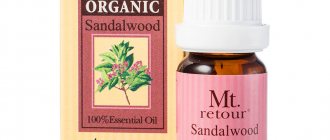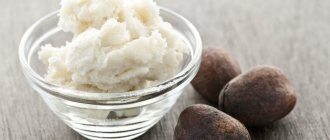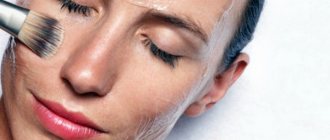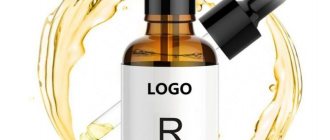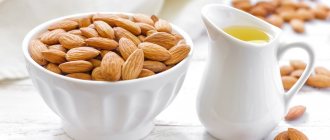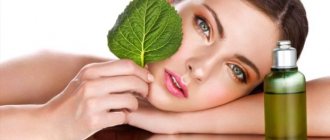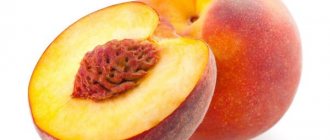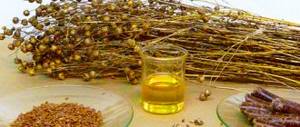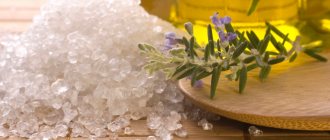Properties of essential oils
Every essential oil has certain properties that can be useful for each of us. A simple pivot table will show them most clearly.
Essential oils are natural remedies in which everyone can find beneficial qualities.
Table: properties of essential oils
| Plant | Properties of its essential oil |
| Anise | It has an antiseptic and expectorant effect, regulates the functioning of the gastrointestinal tract and kidneys (including relieving colic), relieves headaches and depression, eliminates wrinkles and tightens the skin. |
| Orange | It has antiseptic, antispasmodic, diuretic and choleretic properties, prevents wrinkles and cellulite, whitens the skin. |
| Basil | Regulates blood pressure, as well as the functioning of the immune and nervous systems, tones and refreshes the skin. |
| Immortelle | Improves the functioning of the gastrointestinal tract, immune and circulatory systems, has anti-inflammatory and antibacterial effects, cleanses the body of toxins and parasites. |
| Valerian | It has a sedative and relaxing effect, helps cope with depression and insomnia, and relieves spasms of blood vessels and muscles. |
| Verbena | Relieves muscle spasms and helps restore them after injuries, improves hormonal levels, regulates the sebaceous and sweat glands and cleanses and smoothes the skin. |
| Carnation | It has antiseptic and antispasmodic properties, improves the functioning of the gastrointestinal tract and circulatory system, disinfects skin and wounds, preventing the formation of abscesses. |
| Spruce | Strengthens the immune system, has antiseptic and antibacterial effects, regulates the functioning of the genitourinary system, eliminates dandruff and strengthens hair roots. |
| Ginger | Tones and warms, has antiseptic, antiviral and antibacterial effects, regulates metabolism, reduces swelling, and is also effective against lichen. |
| Camphor | Improves the functioning of the circulatory, immune and digestive systems, has expectorant and anti-cold properties, relieves pain in the head, muscles and joints. |
| Kayaput | A strong antiseptic, has antibacterial and antiviral effects, fights stomach and intestinal colic, relieves pain and inflammation of muscles and joints, as well as toothache. |
| Turmeric | Regulates the functioning of the gastrointestinal tract, relieves colic, increased gas formation, as well as parasites, has an antispasmodic effect and prevents the development of tumors. |
| Lime | It has an antiseptic, bactericidal, hemostatic effect, regulates the functioning of the sebaceous and sweat glands, and prevents the development of cellulite. |
| Magnolia | Improves the functioning of the immune, cardiovascular and nervous systems, lowers blood pressure, pulse rate and temperature, relieves stress and relaxes. |
| Marjoram | Regulates digestion and blood pressure, cleanses the body of toxins, improves sleep and calms, eliminates swelling, calluses, warts and wrinkles. |
| Melissa | It has analgesic and anticonvulsant effects, helps with dizziness and migraines, lowers blood pressure and temperature, strengthens hair and treats problematic skin. |
| Monarda | A very strong antiseptic, it also has a pronounced antibacterial and fungicidal effect, helping to protect the body from radiation. |
| Nutmeg | Warms and tones, has an antibacterial and antifungal effect, relieves swelling, stops bleeding, stimulates hair growth and prevents hair loss. |
| Oregano (oregano) | Regulates the gastrointestinal tract and metabolism, improves appetite, eliminates hemorrhoids, hangover syndrome, as well as pain in the teeth, muscles, and joints. |
| Parsley | Improves the functioning of the digestive and genitourinary systems, eliminates colic, gas, hemorrhoids and diarrhea, strengthens teeth and gums, regulates menstruation and helps relieve pain during it, relieves swelling. |
| Sagebrush | It has a strong disinfectant, bactericidal, fungicidal and insecticidal effect, lowers blood pressure and temperature. |
| Rose | Strengthens the nervous, endocrine and digestive systems, helps prevent cancer and atherosclerosis, evens out skin color and tones it, and is effective against edema. |
| Thuja | It has a pronounced sedative and relaxing effect, tones the nervous system, regulates the menstrual cycle, is effective against frigidity and impotence, as well as against allergies and tumors. |
| Fennel | Regulates digestion and appetite, eliminates bloating, nausea and colic, is effective for nicotine and alcohol poisoning, regulates the menstrual cycle and relieves PMS. |
| Citronella | Tones and strengthens the immune system, improves hearing, is effective against depression, migraines, dizziness, neuralgia, regulates the sebaceous glands, cleanses the skin, fights acne and inflammation. |
| Thyme (thyme) | Improves digestion and appetite, strengthens the immune system, teeth and gums, increases blood pressure, has a strong disinfectant and antiseptic effect, and eliminates cellulite. |
| Tea tree | It has the strongest bactericidal, antiviral and fungicidal effect, protects against carcinogens and radiation, strengthens the immune system, eliminates swelling, rashes, warts, dermatitis, and herpes. |
Enrichment of standard skin care products with esters
Essential oils can be added to skin care products. These can be creams, lotions, tonics, scrubs or masks. Approximately two or three drops of essential oil per 10 g of product. It is best to add esters immediately before using a cosmetic product. The most effective way is to add essential oil to natural cosmetics made with your own hands or by a cosmetologist. This will be much better, more useful, and the effect of such a filled product will be several times greater than from a store-bought cream or mask.
Oil compatibility
Often in aromatherapy, not one essential oil is used, but several different ones at once. Correctly compiling a suitable perfume composition is not such a simple matter, but the table of essential oil combinations will help you cope with this.
Essential oils must be combined correctly
Table: combinations of essential oils
| Orange | Basil | Bergamot | Carnation | Spruce | Ylang-ylang | Cedar | Cypress | Cinnamon | Lavender | Lemon | Lemongrass | Mandarin | Juniper | Mint | Neroli | Patchouli | Rosemary | Pine | Tea tree | Fennel | Eucalyptus |
| Orange | ✓ | ✓ | ✓ | ✓ | ✓ | ✓ | ✓ | ✓ | |||||||||||||
| Basil | ✓ | ✓ | ✓ | ✓ | ✓ | ✓ | |||||||||||||||
| Bergamot | ✓ | ✓ | ✓ | ✓ | ✓ | ✓ | ✓ | ✓ | ✓ | ✓ | ✓ | ✓ | ✓ | ✓ | ✓ | ||||||
| Carnation | ✓ | ✓ | ✓ | ✓ | ✓ | ✓ | ✓ | ✓ | |||||||||||||
| Spruce | ✓ | ✓ | ✓ | ✓ | ✓ | ✓ | ✓ | ✓ | ✓ | ✓ | |||||||||||
| Ylang-ylang | ✓ | ✓ | ✓ | ✓ | ✓ | ✓ | ✓ | ✓ | ✓ | ✓ | ✓ | ||||||||||
| Cedar | ✓ | ✓ | ✓ | ✓ | ✓ | ✓ | ✓ | ||||||||||||||
| Cypress | ✓ | ✓ | ✓ | ✓ | ✓ | ✓ | ✓ | ✓ | ✓ | ||||||||||||
| Cinnamon | ✓ | ✓ | ✓ | ✓ | ✓ | ✓ | ✓ | ✓ | |||||||||||||
| Lavender | ✓ | ✓ | ✓ | ✓ | ✓ | ✓ | ✓ | ✓ | ✓ | ✓ | ✓ | ✓ | ✓ | ✓ | |||||||
| Lemon | ✓ | ✓ | ✓ | ✓ | ✓ | ✓ | |||||||||||||||
| Lemongrass | ✓ | ✓ | ✓ | ✓ | ✓ | ||||||||||||||||
| Mandarin | ✓ | ✓ | ✓ | ✓ | ✓ | ✓ | ✓ | ✓ | ✓ | ||||||||||||
| Juniper | ✓ | ✓ | ✓ | ✓ | ✓ | ✓ | ✓ | ✓ | ✓ | ✓ | |||||||||||
| Mint | ✓ | ✓ | ✓ | ✓ | ✓ | ✓ | ✓ | ✓ | ✓ | ||||||||||||
| Neroli | ✓ | ✓ | ✓ | ✓ | ✓ | ✓ | ✓ | ✓ | ✓ | ✓ | ✓ | ✓ | ✓ | ||||||||
| Patchouli | ✓ | ✓ | ✓ | ✓ | ✓ | ✓ | ✓ | ✓ | |||||||||||||
| Rosemary | ✓ | ✓ | ✓ | ✓ | ✓ | ✓ | ✓ | ✓ | ✓ | ✓ | ✓ | ✓ | |||||||||
| Pine | ✓ | ✓ | ✓ | ✓ | ✓ | ✓ | ✓ | ✓ | ✓ | ✓ | |||||||||||
| Tea tree | ✓ | ✓ | ✓ | ✓ | ✓ | ✓ | |||||||||||||||
| Fennel | ✓ | ✓ | ✓ | ✓ | ✓ | ||||||||||||||||
| Eucalyptus | ✓ | ✓ | ✓ | ✓ | ✓ |
Massage with essential oils
Aromatherapy facial massage is a highly effective procedure. Massage stimulates the deep layers of the skin, improves blood circulation and metabolism in tissues. At the same time, beneficial substances from essential oils are supplied, which enhances the effect.
For massage, you can use either a cream enriched with essential oil or a mixture of base + essential oil. Massage technique – any one you know. For example, the popular Japanese facial massage Asahi will come in handy. It can be done on a daily basis.
Application in cosmetology
Now that we know how plant esters work and combine with each other, it makes sense to consider their use in practice.
Oils for your skin
The use of essential oils in the process of creating and improving cosmetics, especially those intended for the face, should be extremely careful. They cannot be used in pure, undiluted form, with the exception of the safest ones - tea tree and lavender. First you need to mix a few drops of ether with base oil, cream or shampoo and only then apply the resulting product to the skin. It is extremely important not to overdo it with the active ingredient: take no more than 3-5 drops per 15 ml of base oil, no more than 10 drops per 100 ml of shampoo, conditioner or conditioner, and no more than 15 drops per jar of thick cream. You can also make your own facial scrub or mask.
Essential oils are not recommended for use in their pure form.
Video: masks with essential oils
First of all, you need to determine your skin type, since the varieties of both essential and base oils will depend on this. For oily skin care, the best oils are grape and watermelon seeds, as well as macadamia and hazelnut, and essential oils are cinnamon, eucalyptus, clove, camphor, fir, lemongrass, citronella or patchouli.
And geranium and bergamot esters will help cope with acne. Dry skin will best accept oils such as orange (unless you are allergic to citrus fruits), rose, chamomile, and rosewood, mixed with the softest bases - almond, peach, avocado, olive, apricot oils. Essential lavender extract and the same tea tree, mixed with sesame oil or jojoba, are included in cosmetics for any skin type.
If you intend to cover your skin with an even layer of tan, then you should pay attention to those ingredients that will increase the photosensitivity of the skin. For 100 ml of walnut oil (or sea buckthorn, cottonseed, coconut, St. John's wort, baobab) you need to add no more than 30 drops of turmeric or wild carrot ether. You can also use citrus fruits - orange or lemon - as essential activator oils. But with neroli, lime, tangerine and bergamot you should be careful. They can be used only in the evenings and only starting from the fourth day of regular sunbathing.
Some essential oils help achieve an even, beautiful tan.
Essential oils for massage
To use essential oil for aromatherapy massage, you must, again, mix it with the base oil. The base should not be too greasy so as not to leave a sticky film on the skin, so it is best to take oil from grape or apricot seeds, shea butter, almonds, jojoba or macadamia. For a couple of tablespoons of base, take 5-6 drops of ether.
For massage, essential oil is mixed with base oil.
For example, for an anti-cellulite massage mixture, you need to take 20 ml of almond oil and add a couple of drops of orange, lime and thyme esters. And to give freshness and vigor to aging skin, take 3 drops of anise and mint esters per 20 ml of shea butter.
Cosmetologist's advice
Before using essential oils for skin elasticity, a dry face must be cleansed in the morning with lotion, milk or infusions of medicinal plants.
Then it is recommended to apply cream or moisturizing oil to damp skin.
Recipe 6
You will need:
- Sandalwood essential oil – 5 drops
- Rosewood essential oil – 5 drops
- Avocado vegetable oil – 20 ml
- Vegetable oil from grape seeds - 20 ml
- Olive oil – 40 m
Soothing oils.
Soothing oils relieve unpleasant symptoms while repairing damaged skin. To prepare them, you need to mix all the ingredients below.
It is recommended to rub oils into damp skin with light movements. They are great for daily use.
Recipe 1
You will need:
- Neroli essential oil – 5 drops
- Jasmine essential oil – 3 drops
- Avocado vegetable oil – 20 ml
- Vegetable oil from grape seeds - 20 ml
- Olive oil – 40 ml
Recipe 2
You will need:
- Chamomile essential oil – 10 drops
- Rose essential oil – 5 drops
- Avocado vegetable oil – 20 ml
- Vegetable oil from grape seeds - 20 ml
- Olive oil – 40 ml
Recipe 3
You will need:
- Lavender essential oil – 10 drops
- Fir essential oil – 5 drops
- Avocado vegetable oil – 20 ml
- Vegetable oil from grape seeds - 20 ml
- Olive oil – 40 ml
Protective creams.
Dry skin is most susceptible to external factors; before going outside (especially in winter), you need to apply special creams to your facial skin about 30-40 minutes before going outside.
They not only protect it from harmful environmental influences, but also supply it with essential nutrients. If the face cream with essential oil does not have time to be absorbed, then you should carefully remove the excess with a soft cloth.
It is recommended to use protective cream daily before going outside.
Recipe 1
You will need:
- Jasmine essential oil – 5 drops
- Avocado vegetable oil – 5 ml
- Vegetable soybean oil - 10 ml
- Vegetable almond oil – 15 ml
- Cocoa butter – 7 g
- Beeswax – 4 g
- Stearic acid – 5 g
- Mineral water – 25 ml
Cooking method
Place wax, cocoa butter, stearic acid and vegetable oils in a small porcelain cup, place it in a water bath and heat the contents until a creamy mass is obtained.
Bring mineral water to a boil and then cool it to 60 °C.
Remove the cup from the water bath and pour mineral water into it. Mix the contents thoroughly - preferably using a mixer - until a liquid mixture forms.
When the mixture reaches room temperature, add essential oil to it and mix again. Then pour the finished product into a cream jar. This cream can be stored for up to 3 months.
Recipe 2
You will need:
- Rose petal essential oil – 5 drops
- Geranium essential oil – 5 drops
- Jojoba vegetable oil – 30 ml
- Lecithin – 4 g
- Decoction of rose petals – 20 ml
- Chamomile decoction - 20 ml
Cooking method
Place an enamel bowl of water on the fire, place two glass containers in it: one with jojoba vegetable oil, and the other with a mixture of decoctions of rose petals and chamomile.
As soon as the water temperature in the containers reaches 60 °C, carefully add lecithin to the oil. When it is completely dissolved, stirring quickly and continuously, pour the broth into the same container.
Once the mixture is smooth, remove the cream from the heat and place in a bowl of cold water. Then, when the cream temperature reaches 35-40 °C, add essential oils and mix.
Transfer the cream into a jar and refrigerate. Lecithin cream can be stored for no more than 7 days.
Nourishing masks.
Nourishing masks are very useful for dry skin. Thanks to the correctly selected composition, their use helps normalize blood circulation and cell regeneration.
As a result, facial skin color improves, it becomes smoother and silkier. To achieve the desired effect, nourishing face masks with essential oil must be done regularly, at least once a week.
Recipe 1
You will need:
- Essential oil nerol and - 3 drops
- Orange essential oil – 1 drop
- Egg yolk – 1 pc.
Cooking method
Beat the yolk, add essential oils. Apply the resulting mixture to your face with a soft brush. When the mask dries a little, apply a second layer.
Wash off the mask after 15-20 minutes, first with warm and then cool water.
Recipe 2
You will need:
- Rosemary essential oil – 5 drops
- Olive oil – 50 ml
Cooking method
Heat olive oil in hot water. Add rosemary essential oil to it. Steam your face with a hot towel.
Apply the resulting mixture to your face. Wash off the mask after 5 minutes with warm water and wipe with a towel to remove excess oil.
Recipe 3
You will need:
- Geranium essential oil – 3 drops
- Olive oil – 5 ml
- Carrots - 1 pc.
- Egg white - 1 pc.
Cooking method
Grate a small carrot on a fine grater and mix it with beaten egg white. Add olive oil and geranium essential oil to the mixture.
Apply the resulting mixture to your face. Wash off the mask after 15 minutes with warm water and wipe with a towel to remove excess oil.
Recipe 4
You will need:
- Lavender essential oil – 4 drops
- Olive oil – 10 ml
- Carrot juice – 5 ml
- Cottage cheese - 1 tbsp. l.
Cooking method
Mix fresh cottage cheese, olive oil and carrot juice. Add lavender essential oil to the resulting mixture, mix and apply to the face.
Wash off the mask after 20 minutes with warm water and wipe with a towel to remove excess oil.
Recipe 5
You will need:
- Oregano essential oil – 3 drops
- Olive oil – 10 ml
- Oatmeal - 2 tbsp. l.
- Cream - 2 tbsp. l.
- Honey - 1 tsp.
Cooking method
Mix honey, cream, olive oil and oatmeal. Add oregano essential oil to the resulting mixture.
Apply to face. Wash off the mask after 10 minutes with warm water and wipe with a towel to remove excess oil.
Recipe 6
You will need:
- Bergamot essential oil – 3 drops
- Wax - 2 tbsp. l.
- Honey - 2 tbsp. l.
Cooking method
Stir thoroughly, melting wax, honey and bergamot essential oil over low heat. Apply to face. Wash off the mask after 10 minutes with warm water.
Recipe 7
You will need:
- Orange essential oil – 3 drops
- Chamomile decoction - 1 tbsp. l.
- Wheat sprouts - 1 tbsp. l.
- Wheat germ oil - 1 tbsp. l.
Cooking method
Mix chamomile infusion, wheat germ oil, wheat germ and orange essential oil. Apply to face. Wash off the mask after 15-20 minutes with warm water.
Regenerating lotions.
Dry facial skin needs constant additional hydration and nutrition.
Homemade natural lotions with the addition of essential oils, which have a pronounced softening and cleansing effect, are well suited for its restoration.
Lotions must be applied to the facial skin with a clean cloth, cotton wool or a special swab.
To achieve the effect, you need to moisten a cloth with lotion, apply it to your face and hold for 15 minutes. Such lotions should be used no more than once a week.
Recipe 1
You will need:
- Geranium essential oil – 7 drops
- Chamomile flowers - 1 tbsp. l.
- Mint leaves - 1 tbsp. l.
- Linden flowers - 1 tbsp. l.
- Avocado vegetable oil - 10 ml.
Cooking method
Mix chamomile flowers, mint leaves and linden flowers. Pour 2 tbsp. l. the resulting mixture with 2 cups of boiling water. Leave for 8-12 hours, strain, add essential and vegetable oils, stir.
Recipe 4
You will need:
- Chamomile essential oil – 7 drops
- Linden blossom - 2 tbsp. l.
- Honey - 1 tsp.
Cooking method
Brew linden flowers with 1 cup of boiling water, leave for 10-15 minutes and strain. Mix honey with linden blossom infusion and add chamomile essential oil.
Oily skin has an unnatural shine and open pores. Spots, pimples and blackheads may appear on it. This type of skin requires constant care and regular cleansing.
Cleansing oils.
Cleansing the skin should always be thorough, but not harmful. Essential oils, in addition to other plant components, enhance the effect of active substances and help remove contaminants.
To prepare a cleansing essential oil for oily skin, you need to mix all the ingredients below.
After this, apply a small amount of oil to damp skin and rub in with light massaging movements.
To achieve the desired effect, cleansing oils are recommended to be used at least 2 times a week.
Recipe 1
You will need:
- Rose petal essential oil – 2 drops
- Geranium essential oil – 2 drops
- Jasmine essential oil – 1 drop
- Schisandra essential oil – 1 drop
- Jojoba vegetable oil – 10 ml
- Almond vegetable oil – 10 ml
- Vegetable oil from grape seeds - 50 ml.
Recipe 2
You will need:
- Lavender essential oil – 8 drops
- Rosemary essential oil – 2 drops
- Sunflower oil – 50 ml
- Vegetable oil from grape seeds - 30 ml.
Recipe 3
You will need:
- Rose petal essential oil – 1 drop
- Cucumber juice – 20 ml
- Sunflower oil – 10 ml
- Cream - 10 ml.
Refreshing lotions.
Refreshing lotions with the addition of essential oils eliminate oily shine, pleasantly refresh the skin, tighten pores and mask minor imperfections. After using them, the skin becomes smooth and uniform, and a healthy complexion is restored. In addition, such products do not dry out the skin.
To prepare refreshing lotions, you need to mix all the ingredients below. Pour 2 tbsp. l. the resulting mixture with 2 cups of boiling water.
Leave for 8-12 hours, strain, add essential oils, stir. Refreshing lotions are suitable for daily use.
Recipe 1
You will need:
- Chamomile essential oil – 7 drops
- Sage leaves - 1 tbsp. l.
- Yarrow herb - 1 tbsp. l.
- Thyme herb - 1 tbsp. l.
- Marshmallow root - 1 tbsp. l.
- Horsetail herb - 1 tbsp. l.
Recipe 2
You will need:
- Tea tree essential oil – 7 drops
- Sage leaves - 1 tbsp. l.
- Yarrow herb - 1 tbsp. l.
- Chamomile flowers - 1 tbsp. l.
- St. John's wort herb - 1 tbsp. l.
Recipe 3
You will need:
- Peppermint essential oil – 5 drops
- Sage leaves - 1 tbsp. l.
- Rose petals—1 tbsp. l.
- Chamomile flowers - 1 tbsp. l.
- Plantain leaves - 1 tbsp. l.
Recipe 4
You will need:
- Ylang-ylang essential oil – 7 drops
- Sage leaves - 1 tbsp. l.
- Yarrow herb - 1 tbsp. l.
- Chamomile flowers - 1 tbsp. l.
- Plantain herb - 1 tbsp. l.
Regenerating creams.
Regenerating creams based on vegetable and essential oils help narrow enlarged pores, help fight inflammation and rashes, while nourishing the skin.
Natural components significantly improve the functioning of its defense mechanisms. These creams are suitable for daily use.
Recipe 1
You will need:
- Schisandra essential oil – 5 drops
- Avocado vegetable oil – 5 ml
- Vegetable almond oil – 15 ml
- Beeswax – 4 g
- Stearic acid – 4 g
- Mineral water - 25 ml.
Cooking method
Place wax, stearic acid and vegetable oils in a small porcelain cup, place it in a water bath and heat the contents until a creamy slurry is obtained.
Bring mineral water to a boil and then cool it to 60 °C. Remove the cup from the water bath and pour mineral water into it. Mix the contents thoroughly (preferably using a mixer) until a liquid mixture forms.
When the mixture reaches room temperature, add essential oil to it and mix again. Then pour the finished product into a cream jar. This cream can be stored for up to 3 months.
Recipe 2
You will need:
- Chamomile essential oil – 2 drops
- Lavender essential oil – 1 drop
- Flaxseed – 20 g
- Flaxseed oil - 5 ml.
Cooking method
Grind flaxseed in a coffee grinder, add boiled water and leave for 12 hours.
Then strain, add linseed oil and essential oils, mix until a gel-like mass is obtained. The cream should be stored in the refrigerator.
Nourishing masks.
For oily facial skin, it is recommended to use essential oils of plants for masks, which contain a large amount of tannins and, therefore, have anti-inflammatory and astringent properties.
It is recommended to use nourishing masks at least once a week.
Recipe 1
You will need:
- Lavender essential oil – 5 drops
- Cream - 1 tsp.
- Peppermint leaves and flowers - 1 tbsp. l.
Cooking method
Pour peppermint leaves and flowers with warm boiled water until a thick paste is obtained. Leave in a boiling water bath for 15 minutes, add essential oil diluted in 1 tsp. cream.
Apply warm paste to your face as a mask and leave for 20 minutes. Rinse off with cool water.
Recipe 2
You will need:
- Ylang-ylang essential oil – 5 drops
- Ginger essential oil – 3 drops
- Bergenia rhizomes - 1 tbsp. l.
Cooking method
Pour crushed bergenia rhizomes into 1 cup of hot boiled water and leave in a boiling water bath for 30 minutes, then leave for another 10 minutes at room temperature, strain.
Add essential oils to the resulting broth and mix. Moisten a napkin with the prepared broth and apply it as a mask on the face, keep for 20 minutes.
Recipe 3
You will need:
- Lavender essential oil – 5 drops
- Rose hips - 1 tsp.
- Mint leaves - 0.5 tsp.
- Sage leaves - 1 tbsp. l.
Cooking method
Pour crushed dry leaves of sage, mint and rose hips into 1.5 cups of boiling water. Leave in a boiling water bath in a tightly sealed container for 30 minutes, cool, strain.
Gently moisten your face with warm infusion. Add lavender essential oil to the boiled thick mass of leaves, apply the mass to gauze, apply it to your face, and hold for 20 minutes. Rinse off with cool water.
Recipe 4
You will need:
- Geranium essential oil – 3 drops
- Tea tree essential oil – 1 drop
- Lemon juice - 1 tsp.
- Egg white - 1 pc.
Cooking method
Beat the egg whites until foamy and, continuing to beat, add lemon juice and essential oils. Apply the resulting foam to your face with a soft brush.
When the mask dries a little, apply a second layer. Wash off the mask after 15-20 minutes, first with warm and then cool water.
Recipe 5
You will need:
- Rosemary essential oil – 3 drops
- Chamomile essential oil – 3 drops
- Olive oil - 1 tsp.
- Starch - 1 tsp.
- Egg white - 1 pc.
- Strawberries - 2 tbsp. l.
Cooking method
Mash the strawberries, mix them with well-beaten egg whites, add starch, olive oil and essential oils to the resulting mixture. Apply to face.
Wash off the mask with warm water after 15 minutes, and then rinse your face with cold water.
Fragrances for treatment
Perhaps there is no area of human health that would not be covered by the healing effect of aromatherapy. In addition to the already well-known massage, there are several of the most popular ways to use essential oil for your benefit:
- aromatic baths. In order to take a therapeutic bath, you must first create an emulsion - dilute a few drops of ether in milk, base oil and honey. Or mix it with sea salt. However, the amount of the substance depends on the volume of water: one drop is taken per 10 liters. Don't neglect the emulsifier, even if you are going to include an essential oil in your bath bomb. Just add a couple of spoons of milk powder or clay to the mixture;
- aroma lamps. Ceramic lamps with a tea candle at the bottom have long gained recognition among aromatherapy fans. Warm water is poured into the recess at the top of the lamp, in which essential oil is then diluted - no more than 4 drops per 10 m2 of room;
- inhalation. For regular inhalation, no special equipment is needed - you can simply inhale the essential oil from the bottle, but you can apply a certain amount of it to a napkin or handkerchief;
- solution. You need to dilute 5-6 drops of ether in 1 liter of water and breathe in the fragrant steam for no more than 5 minutes. If you add an emulsifier (milk, salt, soda or honey) to the solution, you can also rinse your mouth and throat when you are sick. And if you dilute no more than 10 drops per bucket, you can wash floors and wipe furniture to scent and disinfect the air - this way you will get better faster;
- aromatic medallion. An original neck decoration can be useful if you moisten it with 2-3 drops of essential oil. In earlier times, a bag of incense was usually worn around the neck, but now a whole range of beneficial aromas is available to you. It is best to make a medallion from wood, leather or fabric - these materials absorb esters better and retain them longer than metal or ceramics;
- aromatic compress. A handkerchief or napkin should be soaked in scented water and then applied to the affected area - it could be a wound, a joint that is bothering you, a sprained muscle, or a sore organ. Water is prepared at the rate of 5 drops of essential oil per glass.
Video: DIY aromatic bath
Table: use of essential oils in medicine
| Scope of application | Essential oil | Mode of application |
| Headache, migraine | Camphor, rose, ginger, anise | Bath, lamp, compress, inhalation |
| Diseases of the lungs and bronchi | Spruce, ginger, tangerine, thyme, tea tree, lime | Bath, inhalation, lamp, medallion |
| Gums and teeth | Mint, spruce, fir, thyme, parsley | Rinse |
| Immunity | Tea tree, myrtle, spruce, thyme, citronella | Bath, lamp, medallion, massage |
| Papillomas and warts | Cypress, citronella, lemon, lime, tea tree | Bath, compress |
| Herpes | Lime, ginger, tea tree | Compress |
| Varicose veins | Oregano, magnolia, cypress | Bath, compress, massage |
| Scars, scars, stretch marks | Rose, thuja, tea tree, neroli, mandarin | Bath, compress, massage |
| Dizziness, weakness | Melissa, mint, citronella | Inhalation, medallion, lamp |
| Antiseptics | Camphor, anise, chamomile, cloves, tea tree, eucalyptus, cajuput, wormwood, lime | Compress, inhalation, lamp |
| Allergy | Camphor, myrtle, thuja | Compress, inhalation |
| Parasites in the body | Kayaput, immortelle, turmeric | Inhalation, oral administration |
| Fungus | Tea tree, eucalite, fir, monarda, turmeric, citronella | Compress, bath |
| Pediculosis | Thyme, oregano, lemongrass | Compress, bath |
| Sweating | Camphor, oregano, ginger | Bath, medallion |
| Fever | Cayaput, magnolia, basil, marjoram, lavender | Inhalation, bath, lamp |
| Thyroid | Jasmine, geranium, incense, rose | Lamp, compress, medallion |
| Bedsores | Geranium, tea tree, lavender, myrrh, rosemary | Bath, massage, compress |
| Kidneys and bladder | Cayaput, monarda, spruce, parsley | Bath, compress |
| Pain in muscles and joints | Camphor, cajuput, ginger, verbena, valerian | Bath, lamp, massage, compress |
| Vision | Citrus oils, pine, fir, eucalyptus, lavender | Lamp, compress |
| Bruises | Tea tree, geranium, lavender, rosemary | Compress, bath |
| Aphrodisiacs | Vanilla, ginger, patchouli, sandalwood, ylang-ylang | Bath, lamp, massage |
| Women Health | Ginger, oregano, parsley, neroli, fennel, thuja | Bath, lamp, compress |
| Man's health | Ginger, sandalwood, parsley, thuja | Bath, lamp, compress |
| Air disinfection | Wormwood, thuja, tea tree, cedar, lavender, lemon | Lamp, washing floors and furniture |
Dry skin care
Dry skin looks tight, wrinkles are often noticeable, flaking and itching appear. It becomes a sign of a general lack of moisture in the body.
This skin needs constant hydration. Many cosmetics based on essential and vegetable oils are excellent for these purposes.
Moisturizing oils.
To prepare moisturizing oil, you need to mix all the ingredients below. After this, apply a small amount of oil to damp skin and rub in with light massaging movements.
Moisturizing oils are most often used after taking water treatments. They protect the skin from moisture loss and make it more elastic and firm.
To achieve the desired effect, it is recommended to use moisturizing essential oils for dry skin at least 3 times a week.
Recipe 1
You will need:
- Jasmine essential oil – 3 drops
- Rose flower essential oil – 2 drops
- Vegetable oil from grape seeds - 30 ml
- Sunflower oil – 50 ml
Recipe 2
You will need:
- Cananga essential oil – 5 drops
- Ylang-ylang essential oil – 2 drops
- Lemon essential oil - 1 drop
- Vegetable oil from grape seeds - 20 ml
- Avocado vegetable oil – 20 ml
- Sunflower oil – 40 ml
Recipe 3
You will need:
- Lavender essential oil – 10 drops
- Vegetable almond oil – 20 ml
- Vegetable oil from grape seeds - 20 ml
- Avocado vegetable oil – 10 ml
- Sunflower oil – 50 ml
Recipe 4
You will need:
- Rosemary essential oil – 10 drops
- Vegetable almond oil – 20 ml
- Vegetable oil from grape seeds - 20 ml
- Sunflower oil – 50 ml
Recipe 5
You will need:
- Vetiver essential oil – 5 drops
- Geranium essential oil – 3 drops
- Avocado vegetable oil – 20 ml
- Vegetable oil from grape seeds - 20 ml
- Olive oil – 40 ml
The use of esters for children
A child's body is even more sensitive to the effects of essential oils than an adult. That is why they should be used with extreme caution, strictly observing the dosage. It should be no more than half the amount for an adult - and this is when we are talking about children from 6 to 12 years old. Wormwood, cloves, monarda and thuja are recommended for use no earlier than the child reaches 12 years of age. If he is not even 6, the maximum allowable dose is no more than 2-3 drops per use in the form of a bath, massage, compress, inhalation or aroma lamp in the nursery. And here you should immediately exclude geranium, mint, marjoram, thyme and rosemary from the list of essential oils. As for one-year-old babies and those even younger, they are allowed only tea tree or lavender oil - no more than 1 drop at a time.
Essential oils for children should be used with extreme caution
Moisturizers
Both normal and combination skin constantly needs hydration. The softness and smoothness of the skin depends on many factors, but it is the water content of the skin that plays a key role.
It is possible to achieve the necessary balance thanks to natural creams using essential and vegetable oils. Moisturizing creams are best for daily use.
Recipe 1
You will need:
- Neroli essential oil – 5 drops
- Avocado vegetable oil – 5 ml
- Olive oil – 5 ml
- Vegetable almond oil – 15 ml
- Beeswax – 4 g
- Mineral water – 25 ml
Cooking method
Place the wax and vegetable oils in a small porcelain cup, place it in a water bath and heat the contents until a creamy mass is obtained.
Bring mineral water to a boil and then cool it to 60°C. Remove the cup from the water bath and pour mineral water into it.
Mix the contents thoroughly - preferably using a mixer - until a liquid mixture forms. When the mixture reaches room temperature, add neroli essential oil and mix again. Then pour the finished product into a cream jar.
Recipe 2
You will need:
- Geranium essential oil – 5 drops
- Bergamot essential oil – 2 drops
- Lemon essential oil - 2 drops
- Liquid honey - 1 tsp. l.
- Jojoba oil – 100 ml
- Lemon zest - 2 tbsp. l.
- Lemon juice - 2 tbsp. l.
- Egg yolk - 1 pc.
Cooking method
Prepare an infusion of lemon zest. To do this, add 2 tbsp of fresh zest. l. boiling water, leave for 30 minutes, then squeeze.
You can also grind the dry zest in a coffee grinder, pour boiling water over it, heat for 20 minutes in a water bath, then cool and squeeze. For the base of the cream, mix jojoba oil with egg yolk and liquid honey.
Add lemon juice, infusion of zest and essential oils. Mix well. Store the cream in a dark glass container in the refrigerator.
Nourishing masks.
Nourishing masks improve blood circulation, do not dry out the skin and do not contribute to the secretion of excess fat or enlargement of pores.
In addition to essential plant oils, which contain a large number of substances beneficial to the skin, it is recommended to use natural plant components as the basis of the mask. It is recommended to make masks at least once a week.
Recipe 1
You will need:
- Apricot essential oil – 3 drops
- Bergamot essential oil – 1 drop
- Honey - 1 tsp.
Cooking method
Add essential oils to honey. Gently apply the mixture to your face, avoiding the eye area. Keep the mask on your face for 3 minutes, then rinse thoroughly with warm water.
Recipe 2
You will need:
- Essential oil of oregano – 2 drops
- Yogurt – 50 ml
- Avocado - 0.5 pcs.
Cooking method
Peel and chop the avocado, beat it with yogurt. Add oregano essential oil to the resulting mixture. Apply the mask to your face and keep it on for 20 minutes. Then rinse with warm water.
Recipe 3
You will need:
- Apricot essential oil – 2 drops
- Sour cream - 1 tsp. l.
- Honey - 1 tsp.
Cooking method
Mix sour cream, honey and apricot essential oil. Apply the resulting mixture to your face and keep for 15 minutes. Then rinse thoroughly with warm water.
Recipe 4
You will need:
- Orange essential oil – 4 drops
- Cream - 1 tsp.
- Strawberries - 3 pcs.
Cooking method
Mash strawberries into a pulp, add orange essential oil, previously diluted in cream. Apply the resulting mask to your face and keep for 20 minutes.
Then rinse thoroughly with warm water.
Recipe 5
You will need:
- Geranium essential oil – 3 drops
- Lavender essential oil – 1 drop
- Rowan fruits - 1 tbsp. l.
- Butter - 1 tbsp. l.
- Honey - 1 hour. l.
- Egg yolk - 1 pc.
Cooking method
Grind the honey with egg yolk, butter, add the pulp from the rowan fruits and mix until smooth. Add essential oils to the resulting mixture.
Apply the mask to your face, keep it on for 20 minutes, remove excess with a napkin and rinse with cool water.
Recipe 6
You will need:
- Lemon essential oil - 3 drops
- Lavender essential oil – 1 drop
- Vegetable oil - 1 tbsp. l.
- Honey - 0.5 tsp.
- Apple juice - 0.5 tsp.
- Egg yolk - 1 pc.
Cooking method
Mix thoroughly beaten yolk, vegetable oil, apple juice and honey. Add essential oils to the resulting mixture.
Apply the mask with light rubbing movements onto the face, previously cleansed with warm chamomile infusion.
Hold for 7 minutes, then remove with a cotton swab dipped in cold chamomile infusion. Reapply the mask. Keep for 7 minutes, then rinse with warm water.
Essential oils for expectant mothers
Pregnant women should approach the issue of using essential oils extremely responsibly, since they are responsible not only for their well-being, but also for the health of the unborn child. Firstly, you should not start practicing aromatherapy during this difficult period if you have never done it before. Secondly, the dosage of ethers must be immediately reduced by at least half - for baths and aroma lamps, while direct contact with them (cream, massage, inhalation, compresses) is best avoided. Thirdly, pay special attention to the choice of essential oil. Accepted options include tea tree, lavender, eucalyptus, neroli, orange and rosewood.
There are a number of fragrances that are contraindicated for pregnant women.
Never use cloves, mint, chamomile, lemongrass, ylang-ylang, patchouli, juniper, rosemary, thyme, geranium and rose. However, the most dangerous oil for pregnant women is wormwood oil, which can cause miscarriage.
It is believed that parsley and fennel essential oils can increase lactation after childbirth, but you should consult your doctor before using them, otherwise you may harm both yourself and your baby.
Essential oils for facial skin - benefits and rules of use
If you read my post about what is included in essential oils and how these components affect our body, you probably remembered that essential oils are very good antiseptics.
But this is not the only beneficial property of essential oils for the skin.
The effect of essential oils on our skin is determined by a number of important factors:
- Many essential oils contain phytohormones, which are similar in structure to human hormones, this allows them to establish the balance of hormones in the body, which is necessary to prolong the youth of our body.
- Essential oils have antioxidant properties. They are able to restore the oxygen balance in the body, eliminate the toxic effects of oxygen when there is an excess of it, slow down the aging process, stimulating tissue respiration and blood supply.
- Natural essential oils contain substances necessary for the skin in precisely the molecular form that is most suitable for absorption, which allows for maximum effective impact even on the deepest layers of the skin.
According to the aromatherapy reference book, this mini map of the main effects of essential oils on skin, hair and nails was compiled.
Essential oils application table
Precautionary measures
Since essential oil is a potent concentrate, it must be used wisely and carefully.
Basic Rules:
- never use expired oils. The expiration date should be indicated on the packaging or on the bottle itself. There you can read about the storage conditions for ether, which must be observed;
- do not forget about the accuracy of dosage and compatibility of oils. Dosage instructions should also be included with the purchased oil; they may differ from one manufacturer to another;
- Do not experiment with doses and combinations of essential oils, as well as methods of using them, unless you are an expert in this field. If you have the slightest doubt, it is better to consult a doctor;
- Do not apply ether to the skin undiluted - this can result in at least redness and irritation, and in severe cases, burns and swelling may occur. The skin of children, the elderly, pregnant women and allergy sufferers requires especially delicate treatment;
- People prone to allergies should definitely conduct a preliminary test. To do this, you need to take a bath with one drop of the selected ether, or apply it diluted to the skin, or wear a medallion with the same one drop. It can be used only if an allergic reaction does not appear within three days. Remember that cinnamon, rosemary, thyme and citrus oils are especially allergenic. Therefore, it is better not to use them if your skin is highly sensitive;
- If you suffer from any chronic medical conditions, be sure to consult with an appropriate healthcare professional before attempting aromatherapy.
Essential fakes
With the spread of aromatherapy and the increase in demand for essential oils, many unscrupulous manufacturers of such products have appeared. Buy ethers only in trusted stores, and it is advisable to study the market of manufacturers and choose those you can definitely trust. Oil purchased cheaply in an underground passage may turn out to be a fake. How to distinguish it from the original?
Here are some rules:
- package. Genuine essential oil will always be placed in a dark glass bottle and hermetically sealed, accompanied by a glass dropper for dosing, as well as instructions for use. The inscription on the bottle itself tells only the name of the oil, including the Latin name of the plant, and the chemical composition of the contents. The bottle of oil and everything that comes with it must be packed in a box, which must indicate the manufacturer, terms and conditions of storage, and production date;
- test. After opening the bottle, you can (and should) immediately conduct a test on a piece of litmus paper - the neck of real essential oil should not leave greasy marks. Orange ether, containing rich pigments, always leaves a bright yellow mark. The same thing happens with turmeric and wild carrot oils, but orange oil is the most common and works better for the dough. If it is genuine, then most likely the manufacturer can be trusted;
- smell. Natural essential oil has a complex odor, which, with some experience and skill, can be broken down into its individual components. Accordingly, it should change noticeably after opening the bottle. If this does not happen and the smell only becomes less intense, it means that you have got an artificial flavor in your hands.
Add to cosmetic product
Essential oils can be used to enrich face creams and lotions. But keep in mind: the composition of these products should be as natural as possible, the simpler the better. Including, without artificial fragrances and dyes.
Add 10 drops of essential oil to 30 ml of cosmetic product. You can enrich a whole bottle at once, but there are certain storage conditions. The container should be opaque; it is best to place the mixture in a dark glass jar. It should be stored in the dark and cool.
When using an enriched cosmetic product, check its smell each time. If it changes: it becomes unpleasant, bitter - throw it away without regret. Spoiled oil is very harmful. And, unfortunately, it deteriorates quite quickly, even under proper storage conditions.
Baths and baths
Nothing better helps you relax after a hard day at work than taking a bath with aromatic oil.
To relieve stress and create a pleasant, relaxed state, use sandalwood, lavender, geranium or rose oil. After working hard in the gym, tense muscles also need relaxation; for this purpose, use juniper or verbena oil. Lemon or pine oil will help cure an incipient cold.
Nothing better helps you relax after a hard day at work than taking a bath with aromatic oil.
When mixed, the properties and characteristics of essential oils open up new facets. Using them according to the schemes given in the table, you will achieve an excellent cosmetic effect.
| Description of the problem | Oils used |
| Being overweight | Mix a few drops (no more than 5) of oils: nutmeg, pine, rosemary, juniper, tangerine, lemongrass. Prepare a mixture of 5 drops of juniper and no more than 2 drops of lemon, cypress, and orange. |
| Orange peel (cellulite) | Prepare a mixture of juniper, grapefruit (3 drops each), lemon (4 drops), pine (5 drops) oils. Mix the following oils: orange, tangerine (3 drops each), rosemary (4 drops), bergamot (5 drops). Take 6 drops each of neroli, sandalwood and limmet. |
| Stretch marks | Mix a few drops of your choice (no more than 5 each) of the following oils: rosemary, grapefruit, geranium, frankincense, mint, hyssop, neroli, fennel, tea tree. |
Rules for creating aromatic baths:
- Clean the skin with a hard sponge.
- The water should not be too hot, optimally up to 38C.
- The base for the mixture can be kefir, whey, natural sea salt, honey, any transport oil, milk.
- When taking an aroma bath, do not use shampoos, shower gels, lotions and other cosmetics.
- The duration of the aroma bath should not exceed 25 minutes, and the procedure is carried out no more than three times a week.
- After finishing your aroma bath, allow your body to dry naturally; do not dry yourself with a towel.
In a bath or sauna, it is recommended to add essential oil directly to a ladle of water, which is subsequently poured onto the hot stones. For these purposes, they usually use some kind of pine oil; if desired, you can moisten brooms by mixing essential and transport oil.
How to dilute oil ether
Any essential oil should be diluted with a base oil before applying to the face. The only exceptions are lavender and tea tree. They can be applied undiluted to the skin, pointwise to problem areas (for example, pimples or blackheads). Any neutral oil can serve as a base. Usually it is olive, which in itself is already a source of vitamin E, so necessary for the skin, peach, almond.
The standard essential oil dilution scheme involves combining 10 drops of the base with 2-3 drops of the essential component. The ingredients are shaken and stored in the refrigerator in a glass container. Some oils are very active, so they are diluted in a ratio of 3:15. These are almost all spice oils (ginger, cardamom, coriander, fennel, etc.), grapefruit, lemon, bergamot, and some floral ones.
A few drops of essential concentrate added to the cleansing composition during its preparation will significantly enhance the effectiveness of the mask or compress.
How to use essential oils
Aromatic extracts can help improve the condition of the epidermis if used correctly:
- A high concentration of aromatic substances can cause an allergic reaction. Before using oils, perform an allergy test.
- Essential extracts are concentrated substances, the use of which in their pure form can harm the epidermis. They are added in small quantities to homemade cosmetics.
- Aromatic concentrates are introduced gradually: add 2-3 drops of one type to a homemade cosmetic composition. Carefully monitor the reaction of the epidermis.
- You cannot mix more than seven types of oils within one product.
- One type of ether is used for no more than a month; it is ideal to change it every 2 weeks.
The time of day for application depends on the effect that the ether gives. Toning masks are applied in the first half of the day, relaxing masks in the evening.
Be sure to read:
Effective recipes with sea salt for the face: how to quickly get rid of acne at home

